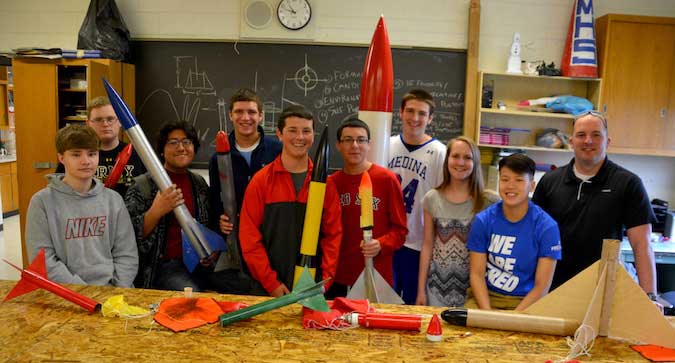Medina students will compete in national rocket launch competition
Press Release, Medina Central School
MEDINA – Medina Technology teacher Mike Lepkyj and ten of his students are heading to Washington, DC to compete in the national finals of the 15th Annual Team America Rocketry Challenge (TARC).
The team’s name is Chris P. Bacon and they will face off against 99 of the top rocketry teams from across the country to claim the title of national champion on May 13. TARC is the aerospace and defense industry’s flagship program and is designed to encourage students to pursue study and careers in science, technology, engineering and math (STEM).
The competition challenges middle and high school students to design, build and fly a rocket that meets specific altitude and flight duration parameters. This year’s rules require a rocket to carry one raw egg to reach 775 feet before returning the egg to Earth, uncracked, all within 41 to 43 seconds.
“This is the first time we are going to the nationals in the five years I have taught here,” said Mr. Lepkyj. “We found out right before spring break and everyone is really excited. We have been learning new techniques every year and it just gets better and better each year. Every year we have come within a hair of winning, so this is great. Each student made a rocket and we narrowed it down to the best by testing them. The design was pretty sophisticated and difficult because each year the criteria for the design changes. We had people come to the high school to record our height and time and we got to a height of 775 feet in 41.43 seconds. It was great to qualify.”

Katie Bilicki assembles a rocket that has four engines. It won’t be used in the upcoming competition. Nick Bogan is at back left and Carson Gates is at right. The rockets in the competition can only have one engine. This rocket, with the four engines, is expected to go more than 2,500 feet high.
The rockets need to be 24.6 inches long. They have to fly and land without breaking the egg, and the rocket needs to be in good enough shape to be flown again.
Student Nick Bogan says he has been taking technology classes since he was a freshman.
“I was taking Advanced Engineering and when I heard they were doing rockets, I knew it would be a great class to join,” Bogan said. “We ended up being successful, so I am pretty happy about that. Going to DC is a great opportunity and this is the first year we have gotten this far. I am really excited. I am not sure how well we will do, but it will be a great experience any way.”
The team’s get three qualifying flights to see if they are eligible for nationals. However, at the national competition, each team gets only one try.
The lower a team’s score, the better. For every foot off 775 feet in height, the team gets a point. For every second off the 41 to 43 second goal, 4 points are added to the total.
There are 816 teams in the country, and only 100 qualify for nationals. Medina students design and make the fins on the rockets, experiment with length of the rocket body, as well as weights and measures.
Students need to consider angling the rocket launch to factor in wind strength. Being off by small percentages can make the rocket from going too high or too low.
Colby Albone said he loves class.
“I think it allows us to get creative and Mr. Lepkyj lets us use our imagination and design whatever we want,” Albone said. “It’s a lot of fun and we use a lot of math and science in hands-on projects.”
“Everyone is very excited about this,” says Mr. Lepkyj. “I have had former students come up to me and they are just as excited about this as my current students. Some of them even came over on the break. It’s a big deal for the students. They will meet and greet with our local elected officials in DC and then get to compete for $150,000 in prizes and scholarships.”
The winning team has the chance to represent the United States at the International Rocketry Challenge at the Paris Air Show in June.
For more on the competition, click here.
(Editor’s Note: Includes reporting by Tom Rivers.)







































































